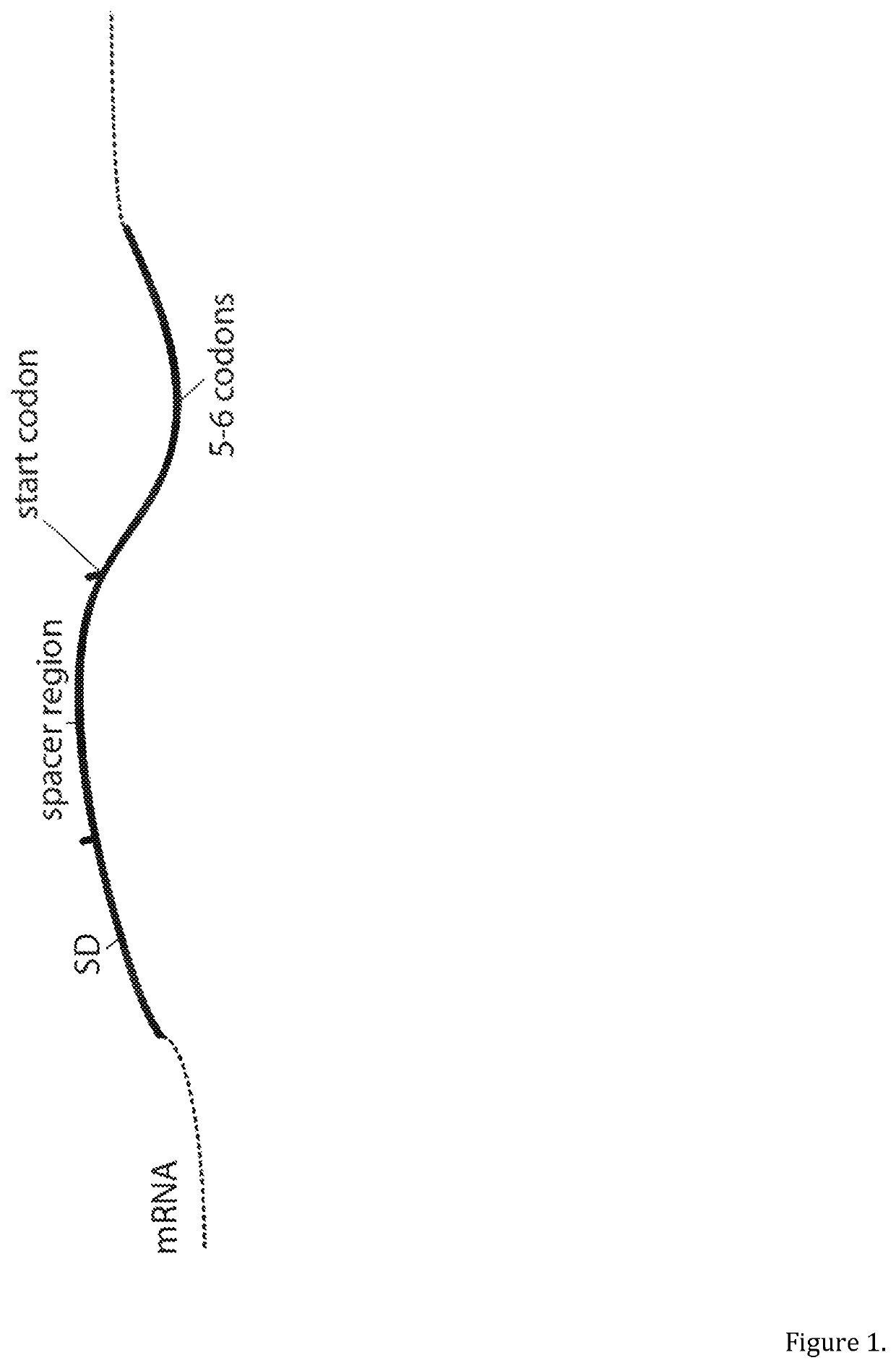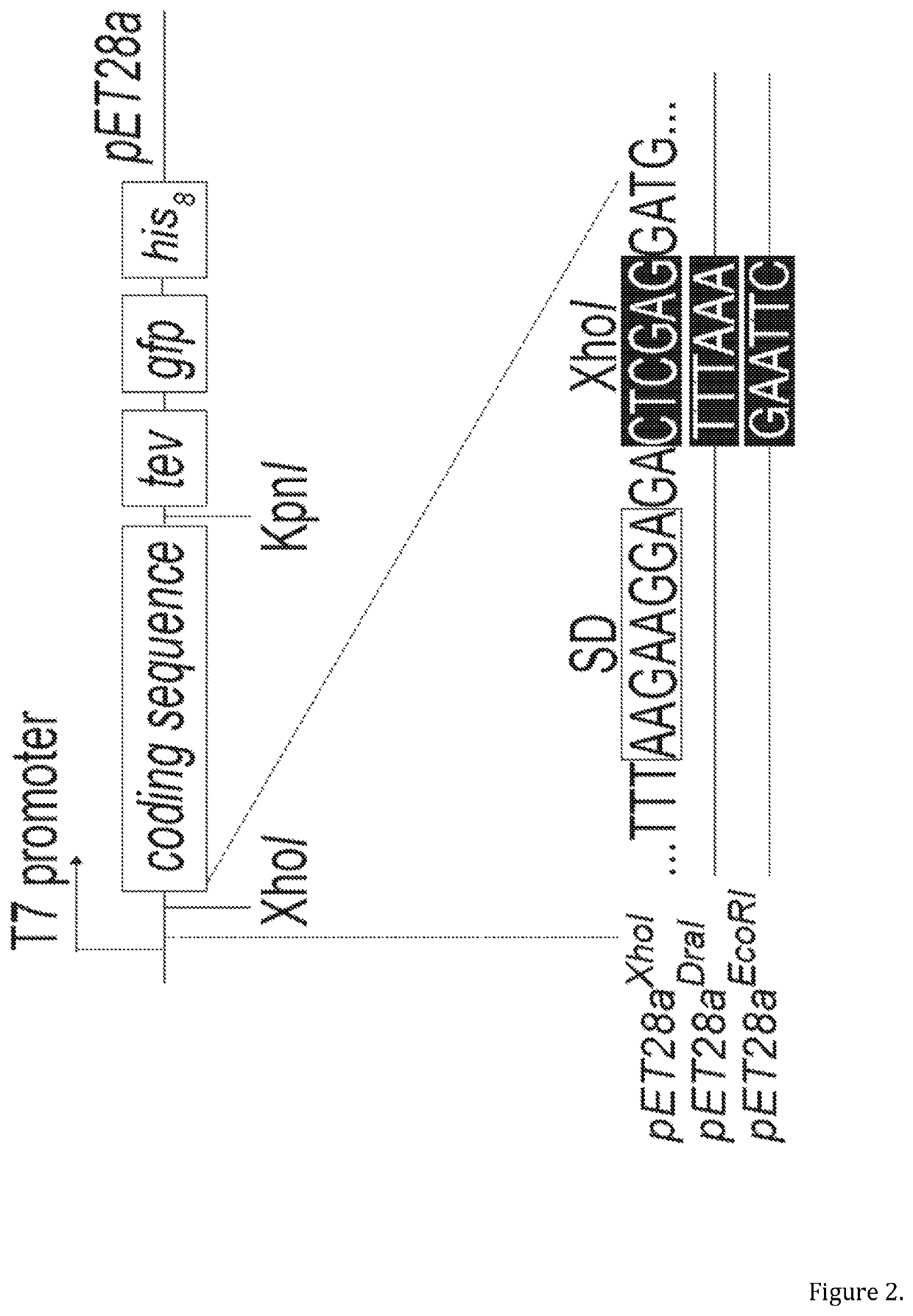Selective optimization of a ribosome binding site for protein production
a ribosome binding site and selective optimization technology, applied in the field of dna constructs for recombinant protein expression, can solve the problems of unpredictable expression levels, rate-limiting step in protein synthesis is translation initiation, and cannot solve the problem of context dependen
- Summary
- Abstract
- Description
- Claims
- Application Information
AI Technical Summary
Benefits of technology
Problems solved by technology
Method used
Image
Examples
example 1
tous Improvements in Expression Efficiency
[0091]Previously we constructed a clone library encoding 501 E. coli inner membrane proteins genetically fused to a -TEV-GFP-His8 tag10. During construction of the library, the CDSs had been cloned into a modified version of the pET28a vector (herein called pET28aXhol), using 5′ Xhol and 3′ Kpnl restriction endonucleases (FIG. 2). The clones were transformed into the BL21(DE3)pLysS strain and expression levels were compared by whole cell fluorescence10. This experiment indicated that a number of CDSs were difficult-to-express, including araHWT and narKWT. araHWT encodes for the membrane component of the arabinose ABC transporter, and narKWT a nitrate / nitrite antiporter of the major facilitator superfamily. Whilst working with these two CDSs we noted that substituting the 5′ Xhol recognition sequence in pET28aXhol to either EcoRl or Dral dramatically increased the level of expression (FIG. 3a). The most likely explanation for this observation...
example 2
c Optimisation of the Vector:CDS Junction of the RBS
[0092]To select the nucleotide composition at the vector:CDS junction in a systematic way, we generated libraries in vitro by PCR using degenerate primers. In this experiment the six nucleotides upstream of the AUG start codon were changed in all possible combinations whilst the six downstream were limited to synonymous codons (FIG. 4). The libraries, called pET28aOPT-araHOPT and pET28aOPT-narKOPT, thus contained up to 24,576 and 49,152 different vector:CDS junctions respectively. Each library was transformed into the BL21(DE3)pLysS strain and expression levels from 96 randomly selected colonies were monitored, as done earlier. We observed a range of expression levels, which differed by approximately 350-fold (i.e. lowest to highest expression; FIG. 5). Two lines of evidence indicated that the differences in expression were caused by differences in vector:CDS junctions, not cell-to-cell variation. (1) Sequencing of five highly-expr...
example 3
pplicability of the Optimisation Method
[0095]The importance and generality of optimisation of the vector:CDS junction was exemplified using an additional nine random clones from our membrane protein-TEV-GFP-His library10. We always observed a range of expression levels when we created libraries of vector:CDS junctions, ranging from 280-fold (pET28OPT-flhBOPT) to 7 fold (pET28OPT-agaWOPT) (FIG. 7). In all cases we could increase expression relative to the original and un-optimised clone. Some of these un-optimised clones were originally difficult-to-express, whilst others originally expressed to reasonable levels.
[0096]Materials and Methods
[0097]Molecular Cloning
[0098]All coding sequences (CDSs) were harboured in a vector derived from pET28a (also called pGFPe), as previously described10. They were genetically fused at the 3′ end to a sequence that encoded the tobacco-etch virus (-TEV-) protease recognition site, the green fluorescence protein (-GFP-) and an octa histidine purificati...
PUM
| Property | Measurement | Unit |
|---|---|---|
| emission wavelength | aaaaa | aaaaa |
| excitation wavelength | aaaaa | aaaaa |
| fluorescent | aaaaa | aaaaa |
Abstract
Description
Claims
Application Information
 Login to View More
Login to View More - R&D
- Intellectual Property
- Life Sciences
- Materials
- Tech Scout
- Unparalleled Data Quality
- Higher Quality Content
- 60% Fewer Hallucinations
Browse by: Latest US Patents, China's latest patents, Technical Efficacy Thesaurus, Application Domain, Technology Topic, Popular Technical Reports.
© 2025 PatSnap. All rights reserved.Legal|Privacy policy|Modern Slavery Act Transparency Statement|Sitemap|About US| Contact US: help@patsnap.com



